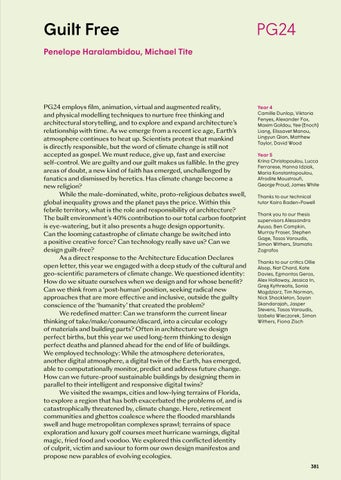Guilt Free
PG24
Penelope Haralambidou, Michael Tite
PG24 employs film, animation, virtual and augmented reality, and physical modelling techniques to nurture free thinking and architectural storytelling, and to explore and expand architecture’s relationship with time. As we emerge from a recent ice age, Earth’s atmosphere continues to heat up. Scientists protest that mankind is directly responsible, but the word of climate change is still not accepted as gospel. We must reduce, give up, fast and exercise self-control. We are guilty and our guilt makes us fallible. In the grey areas of doubt, a new kind of faith has emerged, unchallenged by fanatics and dismissed by heretics. Has climate change become a new religion? While the male-dominated, white, proto-religious debates swell, global inequality grows and the planet pays the price. Within this febrile territory, what is the role and responsibility of architecture? The built environment’s 40% contribution to our total carbon footprint is eye-watering, but it also presents a huge design opportunity. Can the looming catastrophe of climate change be switched into a positive creative force? Can technology really save us? Can we design guilt-free? As a direct response to the Architecture Education Declares open letter, this year we engaged with a deep study of the cultural and geo-scientific parameters of climate change. We questioned identity: How do we situate ourselves when we design and for whose benefit? Can we think from a ‘post-human’ position, seeking radical new approaches that are more effective and inclusive, outside the guilty conscience of the ‘humanity’ that created the problem? We redefined matter: Can we transform the current linear thinking of take/make/consume/discard, into a circular ecology of materials and building parts? Often in architecture we design perfect births, but this year we used long-term thinking to design perfect deaths and planned ahead for the end of life of buildings. We employed technology: While the atmosphere deteriorates, another digital atmosphere, a digital twin of the Earth, has emerged, able to computationally monitor, predict and address future change. How can we future-proof sustainable buildings by designing them in parallel to their intelligent and responsive digital twins? We visited the swamps, cities and low-lying terrains of Florida, to explore a region that has both exacerbated the problems of, and is catastrophically threatened by, climate change. Here, retirement communities and ghettos coalesce where the flooded marshlands swell and huge metropolitan complexes sprawl; terrains of space exploration and luxury golf courses meet hurricane warnings, digital magic, fried food and voodoo. We explored this conflicted identity of culprit, victim and saviour to form our own design manifestos and propose new parables of evolving ecologies.
Year 4 Camille Dunlop, Viktoria Fenyes, Alexander Fox, Maxim Goldau, Yee (Enoch) Liang, Elissavet Manou, Lingyun Qian, Matthew Taylor, David Wood Year 5 Krina Christopoulou, Lucca Ferrarese, Hanna Idziak, Maria Konstantopoulou, Afrodite Moustroufi, George Proud, James White Thanks to our technical tutor Kairo Baden-Powell Thank you to our thesis supervisors Alessandro Ayuso, Ben Campkin, Murray Fraser, Stephen Gage, Tasos Varoudis, Simon Withers, Stamatis Zografos Thanks to our critics Ollie Alsop, Nat Chard, Kate Davies, Egmontas Geras, Alex Holloway, Jessica In, Greg Kythreotis, Sonia Magdziarz, Tim Norman, Nick Shackleton, Sayan Skandarajah, Jasper Stevens, Tasos Varoudis, Izabela Wieczorek, Simon Withers, Fiona Zisch
381
